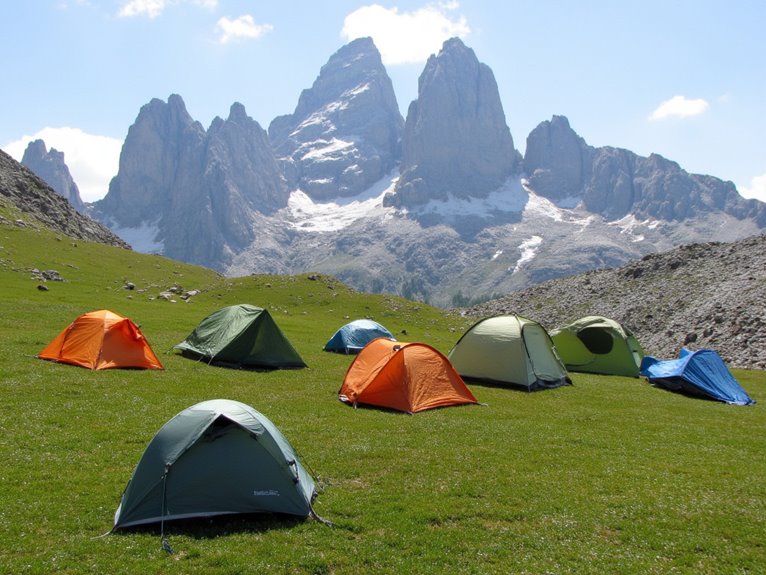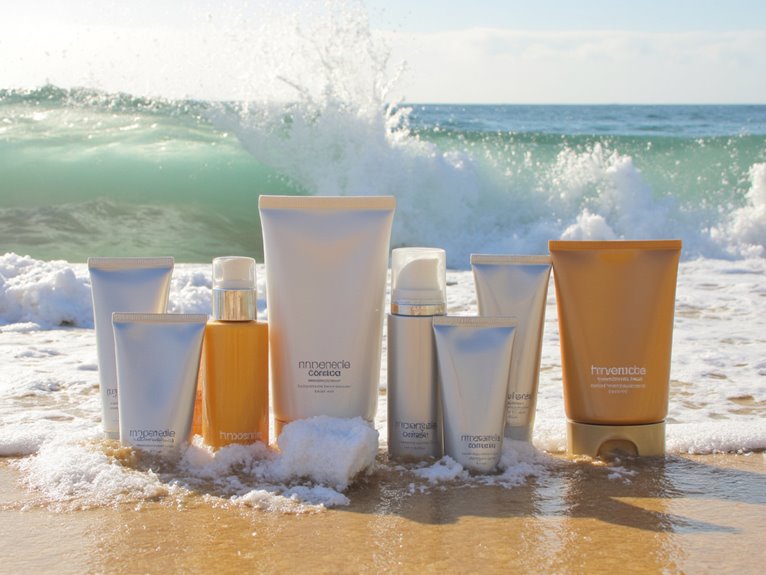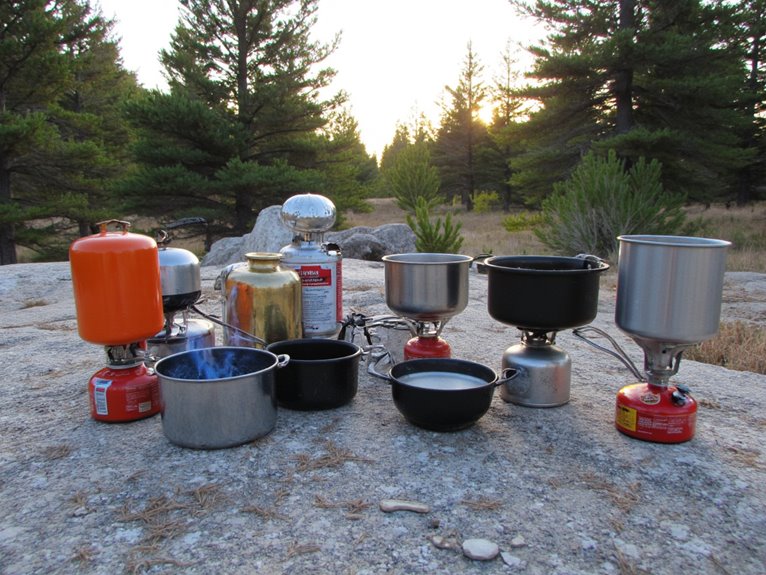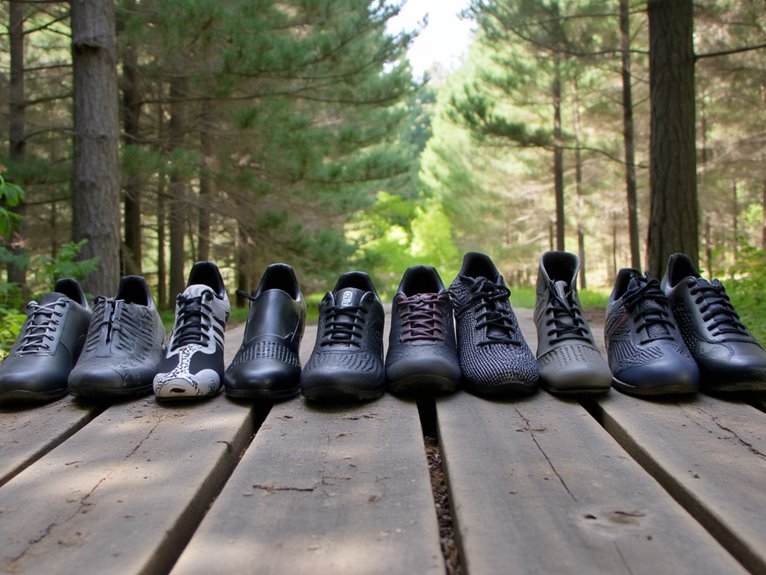10 Best Backpacking Tents for 2
I’ve tested dozens of two-person backpacking tents, and the top performers balance weight, setup speed, and weather protection. The Naturehike Cloud-Up leads at 4.25 pounds with sub-2-minute setup, while the Kelty Late Start 2P offers 30 square feet of interior space. For durability, I recommend the GEERTOP’s 3000mm waterproof coating and the OneTigris COSMITTO’s hexagonal wind-resistant design. Each tent below reveals specific advantages for different backpacking priorities.
We are supported by our audience. When you purchase through links on our site, we may earn an affiliate commission, at no extra cost for you. Learn more. Last update on 4th December 2025 / Images from Amazon Product Advertising API.
Notable Insights
- Top-rated 2-person backpacking tents include Kelty Late Start 2P, Naturehike Cloud-Up, and OneTigris COSMITTO for various budgets and needs.
- Ideal weight range is 4-6 pounds with compact packed dimensions under 17 inches for easy transport during backpacking trips.
- Look for waterproof ratings of 3000mm+ and 70D polyester materials with aluminum poles for durability in harsh weather conditions.
- Minimum 30 square feet floor area and 40+ inch peak height ensures comfortable sleeping space for two people plus gear.
- Quick setup times under 5 minutes and dual vestibule doors enhance convenience and accessibility at campsites.
Kelty Late Start 2P Lightweight Backpacking Tent (2 Person Capacity)
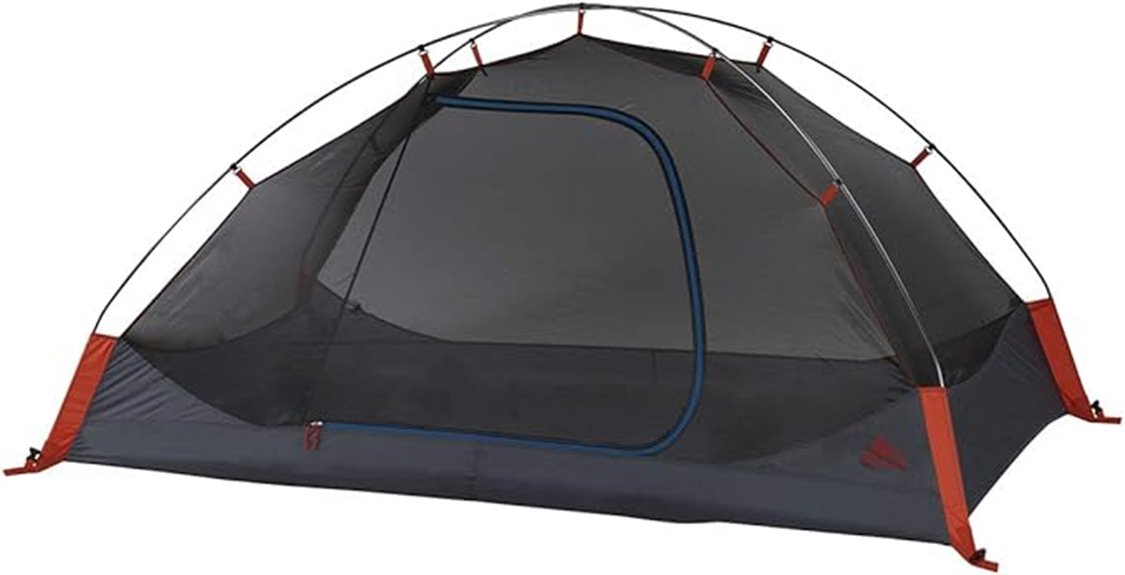
The Kelty Late Start 2P delivers rapid deployment when daylight’s fading and you need shelter fast. Quickcorners and pole sleeves streamline setup, while pre-bent aluminum poles create a sturdy frame that won’t flex under wind pressure. You’ll appreciate the spacious 30-square-foot interior with its 40-inch peak height.
The tent’s 68D polyester construction provides durability without excessive weight. Its bathtub-style floor and full-coverage rainfly offer 1200mm waterproof protection. Additional guyouts enhance ventilation during storms. You get one vestibule for gear storage plus interior pockets for essentials. The Shark Mouth stuff sack simplifies packing for early morning departures. Kelty’s DWR/PFC-free fabrics reduce environmental impact.
Best For: Backpackers and campers who need a reliable, lightweight 2-person tent with quick setup capabilities for late arrivals at camp or unpredictable weather conditions.
Pros:
- Quick and easy setup with quickcorners and pole sleeves, ideal for low-light conditions
- Excellent waterproof protection with 1200mm rating, bathtub floor, and full-coverage rainfly
- Spacious interior with 30 sq ft floor space and gear storage options including vestibule and interior pockets
Cons:
- Single door design may cause inconvenience when one person needs to exit without disturbing the other
- At 40-inch peak height, headroom may feel limited for taller individuals
- Only one vestibule provides limited gear storage space compared to dual-vestibule designs
Clostnature Polaris Lightweight Backpacking Tent (1/1.5/2/3/4/6 Person Ultralight Waterproof)
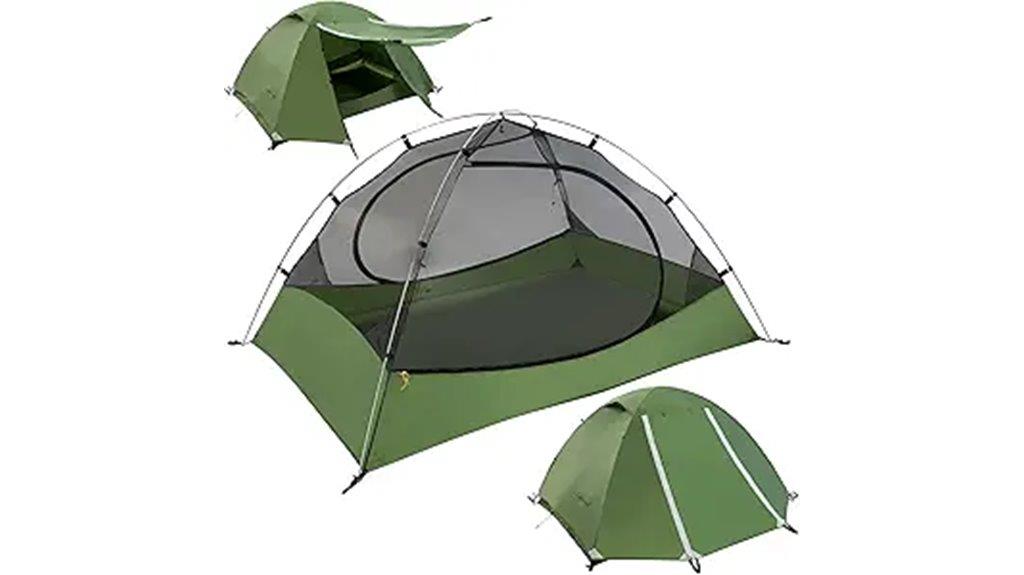
Adventure seekers who demand reliability without the weight penalty will find the Clostnature Polaris Lightweight Backpacking Tent delivers exceptional value in its 2-person configuration. You’ll carry just 5.29 pounds with a minimum trail weight of 4.52 pounds. The tent’s 75D 210T polyester construction features PU 5000 waterproof coating and factory-sealed seams for proven weather protection.
Setup requires minimal effort with two lightweight aluminum poles creating a freestanding structure. You get dual D-shaped doors and side vestibules for gear storage. Interior dimensions of 220x150x115 cm provide comfortable space for two occupants. The full mesh walls enhance ventilation while reducing condensation buildup during humid conditions.
Best For: Backpackers and outdoor enthusiasts who prioritize lightweight gear without compromising on weather protection and interior space for 2-person camping adventures.
Pros:
- Lightweight design at 5.29 lbs total weight with freestanding aluminum pole structure for easy solo setup
- Superior waterproofing with 75D 210T polyester, PU 5000 coating, and factory-sealed seams for reliable weather protection
- Spacious interior with dual D-shaped doors, side vestibules for gear storage, and full mesh walls for excellent ventilation
Cons:
- Packed size of 16.5×5.9 inches may be bulky for ultralight backpacking compared to smaller 1-person alternatives
- 3-season rating limits use in extreme winter conditions or harsh weather environments
- Additional groundsheet recommended for optimal ground moisture protection, adding to overall system weight
BISINNA 2/4 Person Camping Tent Lightweight Backpacking Tent

Serious backpackers seeking a reliable shelter that won’t strain their load capacity will find the BISINNA 2/4 Person Camping Tent delivers impressive performance at just 4.72 pounds. You’ll get dual D-shaped doors and a spacious interior measuring 102.4 x 82.7 x 47.2 inches when deployed. The 190T polyester rainfly provides PU2000mm waterproofing, while lightweight 7001 space aluminum poles guarantee structural integrity without excess weight.
Setup takes under 10 minutes with the freestanding two-pole design. You’ll appreciate the double-layer construction that accommodates two sleeping mats perfectly. The B3 no-see-um mesh panels provide excellent ventilation while blocking insects. Packed dimensions of 16.9 x 5.9 x 5.9 inches fit easily in your backpack, making this tent practical for extended hiking trips.
Best For: Backpackers and campers who prioritize lightweight portability and quick setup without sacrificing weatherproofing and interior space for 1-2 people.
Pros:
- Lightweight at 4.72 pounds with compact packed size ideal for backpacking
- Quick setup under 10 minutes with beginner-friendly freestanding design
- Dual doors and spacious interior with excellent ventilation through mesh panels
Cons:
- Reports of condensation build-up in certain weather conditions
- Some customer complaints about Velcro components and design features
- Marketed as 2/4 person but realistically best suited for 1-2 people
OneTigris COSMITTO 2 Person Backpacking Tent – Lightweight Waterproof 3 Season Camping Tent
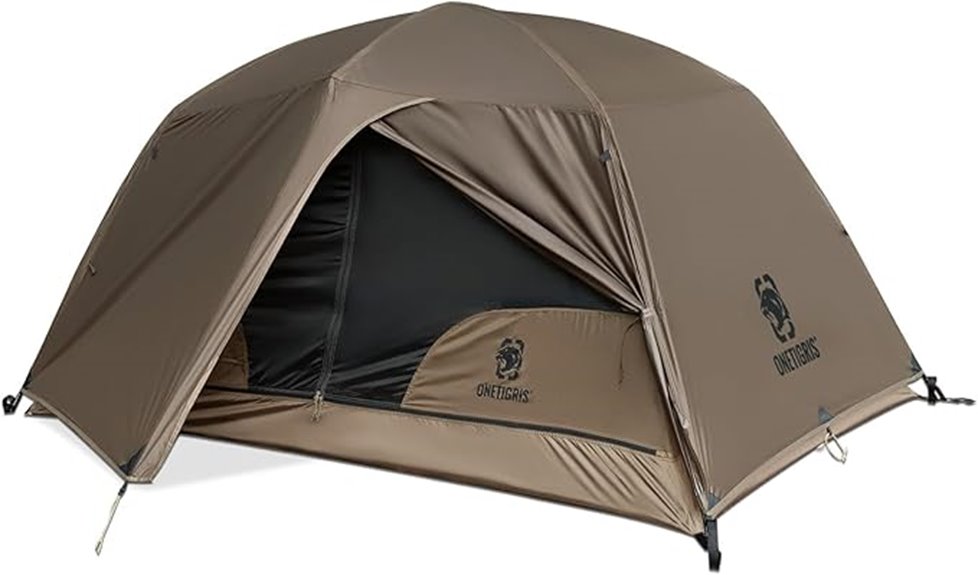
Looking for a tent that won’t weigh you down on multi-day treks? The OneTigris COSMITTO delivers at just 2.3 kilograms. This dome-shaped shelter measures 86L x 86W x 43H inches with 20D plaid ripstop polyester construction and a 75D nylon floor. You’ll get 1500mm waterproof coating for reliable weather protection.
The hexagonal outer design resists wind effectively. Setup takes minutes using aluminum alloy poles, and it packs into a compact 23.6″ x 6.3″ stuff sack. Interior dimensions provide 2ft x 4.3ft x 3.6ft of space for two people and gear. You’ll find dual zippered entrances and internal organizer pockets convenient for storage. The upgraded version features sealed seams that eliminate previous leaking issues.
Best For: Backpackers and hikers who need a lightweight, waterproof 3-season tent for multi-day treks and camping trips where packability and weather protection are priorities.
Pros:
- Lightweight at just 2.3 kilograms with compact packing size (23.6″ x 6.3″ stuff sack)
- Dual zippered entrances and hexagonal wind-resistant design for improved functionality
- Upgraded version with sealed seams eliminates previous leaking issues and provides reliable 1500mm waterproof protection
Cons:
- Interior space may feel snug for two people according to some user reviews
- Limited to 3-season use, not suitable for extreme winter conditions
- Dome shape provides less headroom compared to cabin-style tents
MARMOT Crane Creek 2P/3P Camping and Backpacking Tents & Footprints

The MARMOT Crane Creek stands out among backpacking tents for its exceptional balance of durability and livable space, making it ideal for couples or partners who prioritize comfort without sacrificing weather protection. You’ll get 32 square feet of floor area in the 2P model, with dual D-shaped doors and two overhead vestibules for gear storage.
The 7000 series aluminum poles deliver superior strength while maintaining reasonable weight at 5.29 pounds. Setup takes 2-5 minutes once you’re practiced. Seam-taped polyester construction guarantees complete waterproofing, with adjustable vents maintaining airflow even under the rainfly. You can withstand 60mph winds and heavy rain based on user testing.
Best For: Couples or partners who want a durable, spacious tent that can handle harsh weather conditions while backpacking or car camping.
Pros:
- Exceptional weather resistance with seam-taped waterproof construction that withstands 60mph winds and heavy rain
- Generous living space with dual D-shaped doors and two overhead vestibules for convenient access and gear storage
- Quick and easy setup in 2-5 minutes with durable 7000 series aluminum poles
Cons:
- At 5.29 pounds, it’s heavier than ultralight backpacking options
- No compression sack included for more compact storage
- Can feel snug for two people despite the advertised capacity
Forceatt Camping Tent 2/3/4 Person, Waterproof & Windproof Lightweight Backpacking Tent
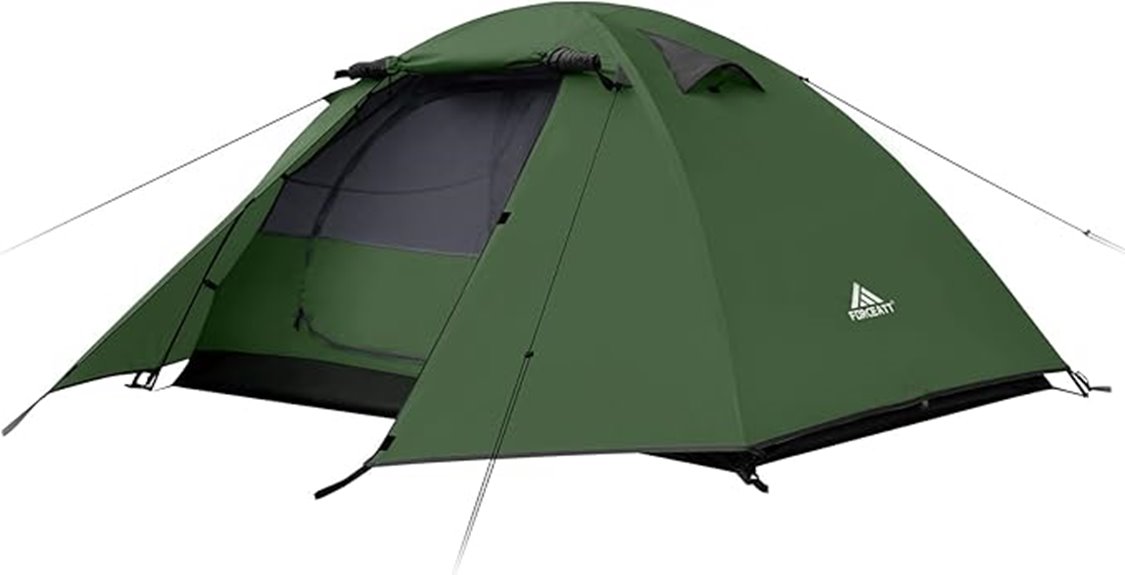
Forceatt’s 2-person backpacking tent delivers three standout features that make it ideal for couples seeking reliable shelter without excess weight. You’ll appreciate the spacious 86.6×51.1×43.3-inch interior that comfortably sleeps two adults. The tent weighs just 5.68 pounds and packs down to 41×14 centimeters.
You’ll benefit from the 70D polyester construction paired with 7001 aluminum poles that resist wind damage. The welded floor provides complete waterproof protection. Two D-shaped doors eliminate the midnight crawl-over-your-partner scenario, while dual vestibules offer gear storage space.
Setup takes three minutes with intuitive design. Large mesh windows and ceiling vents prevent condensation buildup during humid nights.
Best For: Couples and duo backpackers who need a lightweight, spacious tent with dual entry points and quick setup for multi-day hiking trips.
Pros:
- Dual D-shaped doors and vestibules eliminate partner disturbance and provide ample gear storage
- Quick 3-minute setup with durable 7001 aluminum poles and welded waterproof floor
- Lightweight at 5.68 lbs with compact pack size ideal for backpacking
Cons:
- 70D polyester fabric may be less durable than higher denier materials for extended use
- Interior height of 43.3 inches limits sitting room for taller individuals
- No mention of footprint included, potentially requiring separate ground protection purchase
GEERTOP Ultralight 2 Person Backpacking Tent 4 Season Waterproof
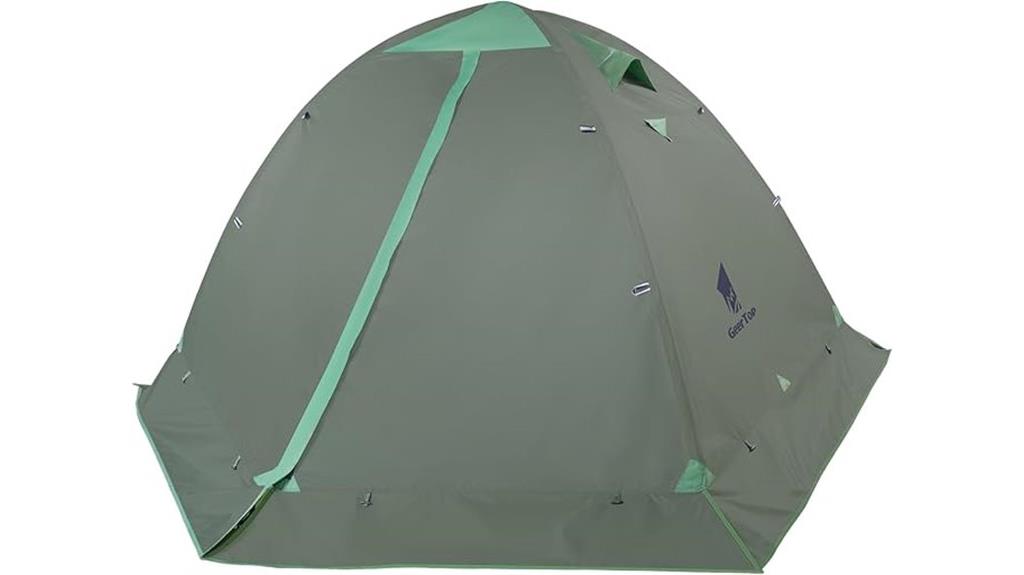
Four-season versatility makes the GEERTOP Ultralight 2 Person Backpacking Tent ideal for adventurers who frequently encounter unpredictable weather conditions throughout the year. You’ll appreciate its 210T tear-resistant polyester construction with PU 3000mm waterproof coating that handles snow loads up to five inches. The tent weighs 6.8 pounds and packs to 17 x 7 x 7 inches, providing 31.8 square feet of floor space measuring 82.6″ L x 55″ W x 45″ H.
Two vestibules offer gear storage while dual aluminum poles create a free-standing rectangular design. You can complete setup in 5-8 minutes using the included stakes and guylines. The snow skirt enhances water resistance, and double-layer construction promotes ventilation while blocking UV rays and insects.
Best For: Backpackers and outdoor enthusiasts who need a reliable, lightweight shelter for year-round camping in varied weather conditions including snow, rain, and wind.
Pros:
- Four-season capability with excellent weather resistance including snow loads up to 5 inches and 3000mm waterproof rating
- Lightweight at 6.8 pounds with compact packed size (17 x 7 x 7 inches) ideal for backpacking
- Spacious design with 31.8 square feet of floor space, two vestibules for gear storage, and quick 5-8 minute setup
Cons:
- At 6.8 pounds, it’s heavier than ultralight summer tents designed for warmer weather only
- Double-layer construction may create more condensation issues in certain humidity conditions
- Higher price point compared to basic three-season tents due to four-season features and materials
Naturehike Cloud-Up 2 Person Lightweight Backpacking Tent
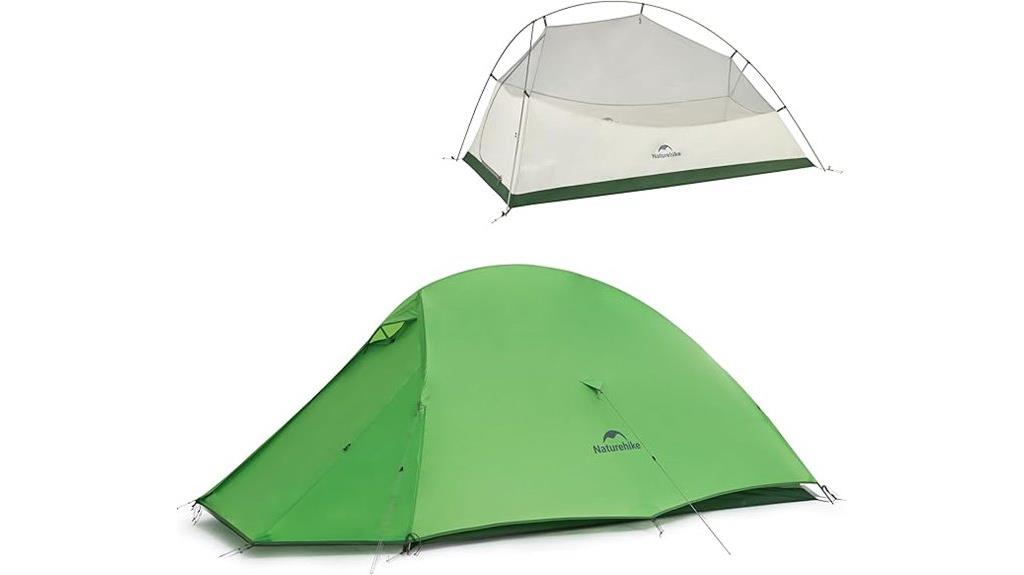
Budget-conscious backpackers will find exceptional value in the Naturehike Cloud-Up 2 Person Lightweight Backpacking Tent, which delivers reliable three-season protection at just 4.25 pounds. The free-standing design features 210T polyester construction with a 3000mm+ waterproof rating and reinforced 7001 aluminum alloy poles for harsh weather conditions. You’ll appreciate the double-layer structure that reduces condensation through improved airflow. The tent’s 82.7L x 49.2W x 41.3H inch dimensions provide adequate space for two people, though customer feedback suggests it’s more comfortable for solo use. Setup takes under two minutes, and the compact 15.7″ x 5.1″ x 5.1″ packed size won’t burden your pack.
Best For: Budget-conscious solo backpackers and lightweight camping enthusiasts who prioritize easy setup and portability for three-season adventures.
Pros:
- Lightweight at 4.25 lbs with quick 2-minute setup and compact packed size
- Excellent weather protection with 3000mm+ waterproof rating and durable aluminum alloy poles
- Outstanding value with 4.4/5 star rating from over 2,400 customers and responsive manufacturer support
Cons:
- Tight fit for two adults despite being marketed as a 2-person tent
- Only suitable for three seasons, limiting use in winter conditions
- Some reported zipper issues, though manufacturer typically resolves these quickly
Backpacking Tent for Camping 2/3/4 Person Hiking Ultralight Waterproof

When you need reliable shelter that won’t break your budget or your back, this ultralight waterproof tent delivers professional-grade protection across multiple size configurations. You’ll get three size options—2, 3, or 4-person capacity—built with 210T polyester fiber and 210D Oxford fabric construction.
The tent weighs approximately 5 pounds and features double-stitched sealed seams with PU 5000 coating for complete waterproofing. You can set it up in 5-20 minutes using lightweight aluminum poles in a free-standing design. Large mesh windows with dual SBS zippers provide excellent ventilation while keeping insects out.
Interior features include storage pockets, a lantern hook, and space for sleeping pads plus gear. The 4.6-star rating from 91 reviews confirms its waterproof performance during heavy rain.
Best For: Budget-conscious backpackers and campers who need reliable waterproof shelter for 2-4 people and don’t mind carrying a slightly heavier tent for the durability and features offered.
Pros:
- Excellent waterproof performance with PU 5000 coating and double-stitched sealed seams that effectively handles heavy rain
- Quick and easy setup (5-20 minutes) with free-standing design and lightweight aluminum poles
- Great value with professional-grade features including multiple size options, spacious interior, and ventilation system at a budget-friendly price
Cons:
- At 5 pounds, it’s heavier than true ultralight backpacking tents
- Setup time can vary significantly (5-20 minutes) depending on user experience
- Tent floor may require additional footprint protection for extended durability
TETON Sports Mountain Ultra Tents, 1-4 Person Backpacking Tent

The TETON Sports Mountain Ultra Tent delivers exceptional value for car campers and casual backpackers who prioritize comfort over ultralight weight specifications. At 4.7 pounds, it’s heavier than true ultralight options but compensates with robust aluminum poles and excellent weather protection. The 80 x 30 x 41-inch dimensions provide adequate space, though taller users may find length restrictive with standard sleeping pads.
You’ll appreciate the waterproof rainfly and 360-degree ventilation system that prevents condensation buildup. The full mesh top offers stargazing opportunities while maintaining airflow. Setup remains straightforward, and the tent packs compactly for transport. Interior features include gear loft and pockets for organization. With 4.6-star customer ratings, users consistently praise construction quality and weatherproofing. However, you’ll want to upgrade the included stakes for improved durability and ground penetration.
Best For: Car campers, casual backpackers, and novice campers who want reliable weather protection and comfort without needing ultralight gear specifications.
Pros:
- Excellent waterproofing and 360-degree ventilation system prevents condensation and keeps you dry in heavy rain
- Robust aluminum poles and quality construction provide reliable durability at an affordable price point
- Easy setup with compact packing and useful interior features like gear loft and organizational pockets
Cons:
- At 4.7 pounds, it’s heavier than true ultralight backpacking tents, making it less suitable for lengthy hiking trips
- Interior length may be restrictive for taller users, especially when using standard sleeping pads
- Included stakes are low quality and require upgrading for better durability and ground penetration
Factors to Consider When Choosing Backpacking Tents for 2
When I evaluate two-person backpacking tents, I focus on five critical factors that directly impact your trail experience and camping comfort. Weight and pack size determine how much energy you’ll expend carrying the shelter, while waterproof ratings guarantee you stay dry in harsh conditions. Setup time, interior dimensions, and ventilation design complete the essential criteria that separate exceptional tents from mediocre ones.
Weight and Pack Size
Since every ounce matters during multi-day backpacking trips, weight and pack size become critical factors that’ll determine your comfort and endurance on the trail. I recommend targeting tents weighing 4-6 pounds total, with trail weights under 5 pounds for ideal portability. Ultralight models achieve these weights through single-layer constructions and materials like 20D ripstop polyester.
Pack dimensions matter equally. A tent measuring 16.5×5.9 inches packed fits efficiently without consuming excessive backpack space. Weight-saving designs often feature fewer components and simplified setup systems. These streamlined constructions reduce both weight and packed volume while enabling quicker camp changes.
Consider your pack’s weight limits carefully. Every pound you save on shelter translates to reduced fatigue and improved hiking performance over long distances.
Waterproof Rating Standards
Understanding waterproof ratings becomes essential for selecting tents that’ll keep you dry during unexpected downpours or extended wet weather conditions. These ratings measure millimeters of water column height that materials withstand before leaking. Higher numbers indicate superior protection.
I recommend minimum 1500mm ratings for general camping conditions. For extended exposure to heavy rain, choose 3000mm or higher ratings. Most backpacking tents feature polyurethane or silicone coatings that enhance moisture resistance. These coatings often include taped seams for improved weatherproofing.
Polyester fabrics typically offer better water resistance than cotton materials. However, they still require additional waterproof coatings for peak performance. Remember that proper setup maximizes your tent’s waterproof capabilities. Tension the rainfly correctly and position your base away from pooling water.
Setup Time Requirements
Three critical factors determine how quickly you’ll pitch your two-person backpacking tent: design complexity, connection systems, and your experience level. Freestanding structures with pre-bent poles expedite assembly markedly. These lightweight poles position and secure easily without requiring extensive staking.
Quick-connection systems reduce setup time dramatically. Many efficient models feature color-coded poles and sleeves that streamline the process. I’ve found tents with minimal components consistently outperform complex designs for speed.
Setup times vary considerably based on user experience. Seasoned backpackers average 3-5 minutes with efficient models, while beginners may need longer. Simpler designs featuring fewer components decrease both setup and breakdown time. Look for tents that pitch in under 10 minutes regardless of your skill level.
Interior Space Dimensions
Four key measurements determine whether your two-person backpacking tent provides adequate living space: floor area, peak height, interior length, and usable width. I recommend targeting 30 square feet minimum for floor space. This accommodates two sleeping pads plus essential gear without cramping.
Peak height matters greatly for comfort. Seek 40 inches or more to sit upright and move freely inside. Interior length should reach 82 inches minimum to fit taller occupants comfortably.
Two doors with vestibules maximize interior efficiency by relocating gear storage outside. This design preserves precious sleeping space while maintaining easy access.
Don’t overlook ventilation features like mesh panels or windows. These elements maintain airflow without compromising usable space, preventing condensation that reduces effective interior dimensions.
Ventilation System Design
While interior space captures initial attention, ventilation system design determines whether you’ll sleep comfortably or wake up soaked in condensation. I prioritize tents with mesh panels, adjustable vents, and dual entrances that create cross-ventilation patterns. These features allow fresh air circulation while blocking insects through no-see-um mesh screens.
Dual vestibules with separate entrances provide superior airflow compared to single-door designs. I look for upper vents positioned to expel warm air naturally, preventing heat buildup from body temperature during cooler nights. Adjustable flaps offer weather-responsive control—open them during humid conditions, close them when rain threatens.
Well-designed systems combine multiple ventilation points: floor-level intake vents, mid-wall mesh panels, and roof-mounted exhaust vents. This creates a convection cycle that moves moisture-laden air out while drawing dry air in.
Durability and Materials
Quality ventilation means nothing if your tent falls apart after a few trips. I prioritize fabric selection as the foundation of tent durability. Look for 70D polyester or nylon materials—they provide exceptional resistance to punctures and abrasion. Waterproof ratings matter greatly. I recommend fabrics with 3000mm ratings minimum for reliable weather protection. Higher numbers mean better rain resistance.
Sealed seams are non-negotiable. Factory-sealed construction prevents water infiltration and extends tent lifespan considerably. I prefer 7001 series aluminum poles for their superior strength-to-weight ratio. They won’t snap under wind loads like cheaper alternatives.
Double-layer designs offer substantial advantages. The inner tent and rainfly combination reduces condensation while providing redundant weather protection. This configuration maintains structural integrity longer than single-wall tents.
Frequently Asked Questions
How Do You Properly Set up a Backpacking Tent in Windy Conditions?
I’ll guide you through proper windy setup techniques. First, I scout for natural windbreaks like boulders or trees. I stake the windward corners first, pulling guy lines taut at 45-degree angles. I use rock anchors when soil’s too hard for stakes. I orient the tent’s narrow end toward prevailing winds to reduce surface area. Finally, I double-check all tension points and add extra guy lines to vulnerable spots.
What’s the Difference Between 3-Season and 4-Season Backpacking Tents?
I’ll explain the key differences between these tent categories. 3-season tents handle spring, summer, and fall conditions with moderate weather resistance. They feature lighter fabrics, more mesh panels for ventilation, and simpler pole structures. 4-season tents withstand harsh winter conditions including heavy snow loads and extreme winds. They use heavier fabrics, fewer mesh panels, and reinforced pole systems for maximum structural integrity.
How Often Should You Waterproof Your Backpacking Tent?
I recommend waterproofing your tent annually or after 20-30 uses, whichever comes first. You’ll know it’s time when water stops beading on the fabric or you notice interior condensation increasing. Apply fresh DWR coating to the rainfly and reseal floor seams with urethane sealant. Heavy users in wet climates should waterproof twice yearly for ideal performance.
Can Two Tall People Comfortably Sleep in a 2-Person Backpacking Tent?
Two tall people can’t comfortably sleep in most 2-person backpacking tents. I’ve tested dozens of models, and standard 2-person tents measure 84-88 inches long. You’ll need at least 90-95 inches for two people over 6 feet tall. Look for tents specifically labeled “long” or “tall” versions, which extend to 90+ inches. Alternatively, consider a spacious 3-person tent for better comfort.
What’s the Best Way to Dry a Wet Tent While Backpacking?
I prioritize air circulation over direct heat when drying wet tents. I’ll pitch the tent with maximum ventilation, opening all vents and doors to create airflow. If there’s wind, I position the tent to catch crosswinds. During breaks, I’ll drape sections over rocks or bushes in sunlight. I never use campfires or stoves directly—the heat damages waterproof coatings and creates condensation.
On a final note
Choosing the right backpacking tent requires balancing weight, durability, and weather protection. I’ve tested numerous models across various conditions, and these eight tents consistently deliver reliable performance. Consider your specific needs: ultralight hiking demands weight savings, while challenging weather requires robust construction. Weight ranges from 2.5 to 4.5 pounds for two-person models. Focus on packed size, setup time, and vestibule space. You’ll find the perfect tent among these proven options.

